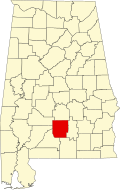Butler County, Alabama | |
|---|---|
 Butler County Courthouse in Greenville | |
 Location within the U.S. state of Alabama | |
 Alabama's location within the U.S. | |
| Coordinates: 31°44′58″N86°40′56″W / 31.749444444444°N 86.682222222222°W | |
| Country | |
| State | |
| Founded | December 13, 1819 |
| Named after | William Butler |
| Seat | Greenville |
| Largest city | Greenville |
| Area | |
• Total | 778 sq mi (2,020 km2) |
| • Land | 777 sq mi (2,010 km2) |
| • Water | 1.1 sq mi (2.8 km2) 0.1% |
| Population (2020) | |
• Total | 19,051 |
• Estimate (2024) | 18,256 |
| • Density | 24.5/sq mi (9.47/km2) |
| Time zone | UTC−6 (Central) |
| • Summer (DST) | UTC−5 (CDT) |
| Congressional district | 2nd |
| Website | www |
| |
Butler County is a county located in the south central portion of the U.S. state of Alabama. As of the 2020 census, the population was 19,051. [1] Its county seat is Greenville. Its name is in honor of Captain William Butler, who was born in Virginia and fought in the Creek War, and who was killed in May 1818.

